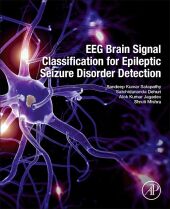 Neuerscheinungen 2019Stand: 2020-02-01 |
Schnellsuche
ISBN/Stichwort/Autor
|
Herderstraße 10
10625 Berlin
Tel.: 030 315 714 16
Fax 030 315 714 14
info@buchspektrum.de |

Satchidananda Dehuri, Alok Kumar Jagadev, Sandeep Kumar Satapathy
(Beteiligte)
EEG Brain Signal Classification for Epileptic Seizure Disorder Detection
2019. 134 S. 229 mm
Verlag/Jahr: ELSEVIER SCIENCE & TECHNOLOGY; ACADEMIC PRESS 2019
ISBN: 0-12-817426-9 (0128174269)
Neue ISBN: 978-0-12-817426-5 (9780128174265)
Preis und Lieferzeit: Bitte klicken
EEG Brain Signal Classification for Epileptic Seizure Disorder Detection provides the knowledge necessary to classify EEG brain signals to detect epileptic seizures using machine learning techniques. Chapters present an overview of machine learning techniques and the tools available, discuss previous studies, present empirical studies on the performance of the NN and SVM classifiers, discuss RBF neural networks trained with an improved PSO algorithm for epilepsy identification, and cover ABC algorithm optimized RBFNN for classification of EEG signal. Final chapter present future developments in the field.
This book is a valuable source for bioinformaticians, medical doctors and other members of the biomedical field who need the most recent and promising automated techniques for EEG classification.
Explores machine learning techniques that have been modified and validated for the purpose of EEG signal classification using Discrete Wavelet Transform for the identification of epileptic seizures
Encompasses machine learning techniques, providing an easily understood resource for both non-specialized readers and biomedical researchers
Provides a number of experimental analyses, with their results discussed and appropriately validated
1. Introduction 2. Literature survey 3. Empirical study on the performance of the classifiers in EEG classification 4. EEG signal classification using RBF neural network trained with improved PSO algorithm for epilepsy identification 5. ABC optimized RBFNN for classification of EEG signal for epileptic seizure identification 6. Conclusion and future research


